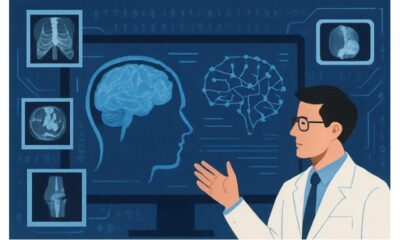Tech
Spotting AI: How to Detect Artificial Content

Differentiating content created by artificial intelligence (AI) from that which is not is getting harder and harder. AI is able to create content that closely resembles writing by humans. The more sophisticated AI systems get, the more important it becomes to be able to recognize artificial stuff. This article offers practical advice for evaluating the integrity of AI-generated content by describing effective methods for recognizing it.
Understanding AI-Generated Content
Like sophisticated language models, AI algorithms are designed to produce text through extensive data analysis. These robots write content that is remarkably similar to human writing—it is cohesive and appropriate to the context. However, compared to human-generated content, AI-generated content typically lacks depth and complexity. More often than not, patterns, statistical correlations, and algorithmic predictions are trusted in place of true understanding or original insight. Finding these telltale signs—like surface-level engagement, repetitious language, or odd linguistic patterns—can be crucial for determining whether or not content was created by artificial intelligence.
Analyzing Language Patterns
An efficient way to identify text created by AI is to examine linguistic trends. AI systems frequently produce material that lacks the organic diversity found in human writing or has certain repetitious structures or phrases that may come out as unduly formal. Unusual language constructions, the frequent use of specific phrases, or an abnormal idea flow are important warning signs. When an AI is used as a writer instead of a human, such patterns can be identified. Examining these components allows one to determine whether sophisticated algorithms created the information or came from a more complex human viewpoint.
Evaluating Contextual Relevance
Sometimes, contextual relevance might be an issue for AI-generated material. Artificial intelligence (AI) systems may produce content that appears pertinent at first glance, but they may miss important details or context. Signs of AI-generated material include information that appears unimportant or disconnected from the primary issues, as well as content that covers the topic in great detail. Furthermore, information provided by AI may not always be current or contain factual inaccuracies because it does not always have access to the most recent data.
Checking for Consistency
Consistency is a key element in identifying information generated by artificial intelligence. AI-generated content may vary in terms of style, tone, and accuracy of the facts. An AI might, for example, communicate opposing ideas in a single paragraph or abruptly transition between formal and informal language. Furthermore, literature produced by AI may contain formatting and linguistic variations that are uncommon in human writing. Analyzing information’s coherence—that is, whether it follows the intended tone and factual accuracy—can help determine whether or not artificial intelligence (AI) was used to develop it. Since human writers are often recognized for their accuracy and consistency, any departures from these norms may be taken as proof that artificial intelligence (AI) has been involved.
Utilizing AI Detection Tools
To aid in the detection of artificial content, various AI detection tools are available that utilize advanced algorithms and methodologies. These tools analyze text for signs of AI generation, including specific linguistic patterns or anomalies that are often indicative of machine-produced content. Some technologies, for example, use machine learning algorithms to match the text with a database of recognized patterns and attributes produced by AI. Additionally, these detectors may assess factors such as text coherence, stylistic uniformity, and the presence of typical AI writing traits. Utilizing an AI detector can significantly enhance the accuracy of identifying artificial content and offer valuable insights into the nature of the text, helping to distinguish between human and machine-generated writing.
Consulting High-Quality Sources
Verifying correctness and credibility is crucial when evaluating the legitimacy of content, and this may be achieved by consulting reliable sources. Verifying the content’s integrity and providing essential context can be achieved by comparing it with authoritative sources or professional perspectives. Reliable sources frequently have depth and subtlety that content generated by AI might not, assisting in ensuring the accuracy and foundation of the information. To improve the overall evaluation and dependability of the content, take into account incorporating information from reputable publications or industry experts for a thorough examination.
Conclusion
Analyzing language patterns, evaluating contextual relevance, verifying consistency, and applying AI detection technologies are all necessary for identifying content created by artificial intelligence. It will become increasingly important to use a combination of these techniques and refer to reliable sources in order to discern between artificial and human material as AI technology develops.
-

 Sports4 weeks ago
Sports4 weeks agoAl Ahly vs Inter Miami, 2025 FIFA Club World Cup – Preview, Prediction, Predicted Lineups and How to Watch
-
Health3 weeks ago
Back to Roots: Ayurveda Offers Natural Cure for Common Hair Woes
-

 Tech3 weeks ago
Tech3 weeks agoFrom Soil to Silicon: The Rise of Agriculture AI and Drone Innovations in 2025
-

 Startup4 weeks ago
Startup4 weeks agoHow Instagram Is Driving Global Social Media Marketing Trends
-

 Science5 days ago
Science5 days agoJuly Full Moon 2025: Everything You Should Need to Know, When and Where to See Buck Moon
-

 Sports3 weeks ago
Sports3 weeks agoFIBA 3×3 World Cup 2025: Full Schedule, Preview, and How to Watch
-

 Gadget3 weeks ago
Gadget3 weeks agoThings to Know about Samsung Galaxy S26: What’s New and What’s Next
-

 Sports4 weeks ago
Sports4 weeks agoWorld Judo Championships 2025: Full Schedule, Date, Time, Key Athletes and How to Watch





















